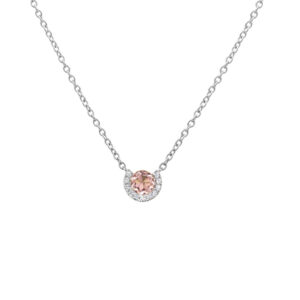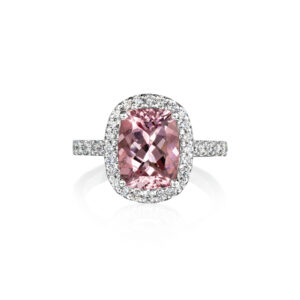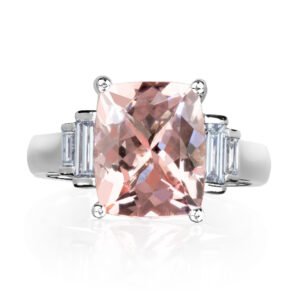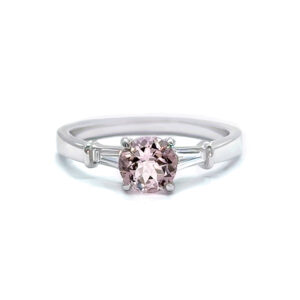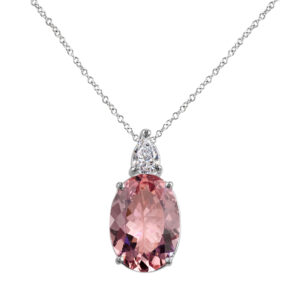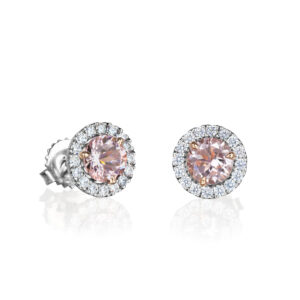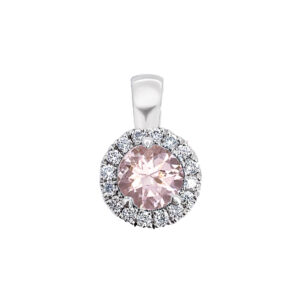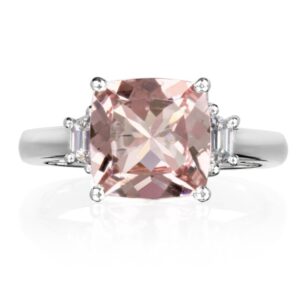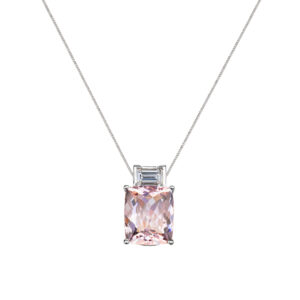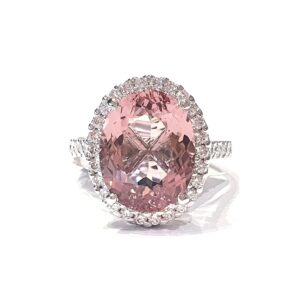Morganite
A relatively new member of the Beryl family, Morganites were first discovered in 1911 in Madagascar. This calm pink gem is a popular Holloway Diamonds stone. We have an amazing collection of stones ready to be set into your style of ring, pendant, or earrings.
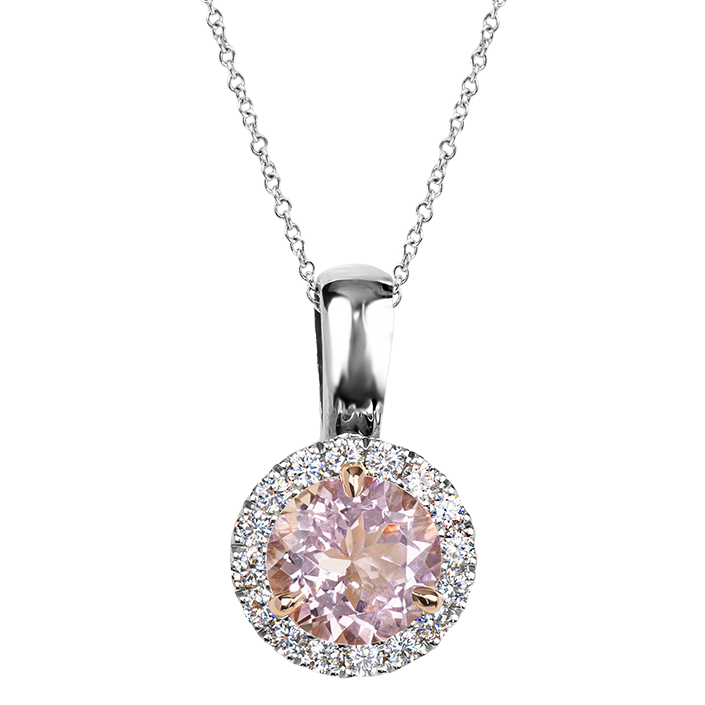
Showing all 15 resultsSorted by latest
-
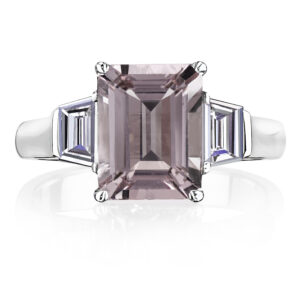
Emerald Cut Morganite & Diamond Ring
-
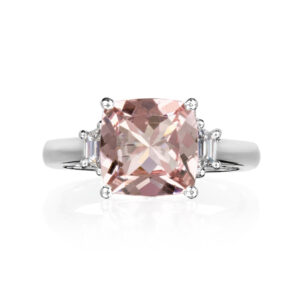
Cushion Cut Morganite & Diamond Ring
-
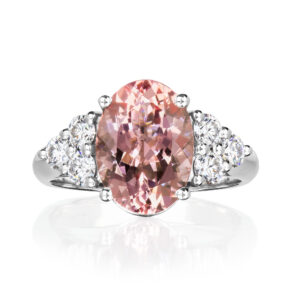
Morganite & Diamond Dress Ring
-
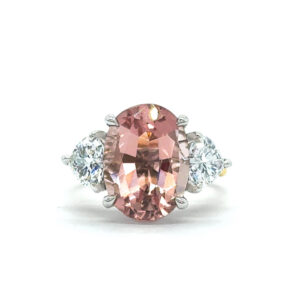
Morganite & Heart Shaped Diamond Ring
-
Sale!
Diamond & Morganite Necklace
-
Morganite & Diamond Halo Ring
-
3.64 carat cushion cut morganite ring
-
Morganite & Diamond Ring
-
Morganite & Diamond Pendant
-
Morganite & Halo Diamond Studs
-
Morganite & Diamond Pendant
-
Morganite and Trapezoid Diamond Ring
-
Morganite Cushion Cut Diamond Pendant
-

Oval Morganite ring with 6 diamonds
-
5ct Pink Morganite Diamond Halo Ring
First Tab - do not remove
Morganite
Morganite is a member of the beryl family, alongside emerald (green beryl) and aquamarine (light blue beryl). Morganite stones ranges from pale pink to coral in colour thanks to traces of manganese in its composition. Pink morganite is a popular alternative to the traditional diamond in a lot of jewellery. As an alternative to diamonds, morganite is the second-most used centrepiece gemstone in engagement rings today, just behind sapphire. You can get a morganite ring with a white gold, yellow gold, rose gold, silver, or other metal for the band just as you would with a traditional diamond ring. Check out Holloway Diamonds’ catalogue of morganite jewellery to see how it fits in your new necklaces and rings!
Is morganite natural or man-made?
Morganite is a naturally occurring gemstone. Much like diamonds, morganite is formed within the Earth, in the cracks and veins of pegmatite rocks. Morganite is formed through the concentration and mineralization of volatile elements in pockets of water during its final stages of crystallisation.
That said, morganite can also be man-made. Synthetic morganite is grown in labs using the same chemical composition, crystal structure, and physical properties as its natural counterpart. Imitation morganite, on the other hand, is simply a look-alike morganite and is not natural.
What is so special about morganite?
Morganite is beloved for its fine pink tones. Pink morganite rings radiate a soft charm and are often said to symbolise innocence, sweetness, and love. It’s also sought after for its hardness (registering at 7.5 to 8 on the Mohs scale), which makes morganite a great gem to use in jewellery and rings.
Is morganite a valuable gem?
Morganite is very rare, but it is considered a semi-precious gemstone. This is because it’s not as rare as diamonds, sapphires, or rubies; morganite falls more in the same category as other coloured stones. That said, its value is still significant, which is proven by the price tags of these highly sought-after pieces.
Is morganite a quality stone?
Morganite is a quality stone due to a combination of its hardness, durability, clarity, and colour. It is a valuable semi-precious gem that is great to use as a centrepiece for all kinds of jewellery. Pink morganite is especially popular nowadays in engagement rings as a more fun and striking alternative to the traditional diamond.
Is morganite durable?
Morganite has a very good hardness rating of 7.5 to 8 on the Mohs scale. While it’s not as durable as diamonds, sapphires, and emeralds, morganite is still a tough semi-precious gem that can stand long on your jewellery pieces—at the fraction of the price of other precious gems. You can get morganite stones on necklaces, rings, pendants, chains, earrings, bracelets, and other pieces of jewellery. Morganite pairs best with silver but can also go with white gold, rose gold, yellow gold, and other metals. These jewellery pieces can be the perfect addition to your collection or as gifts.
Is morganite OK for an engagement ring?
Morganite has become one of the best engagement ring centrepieces. Morganite is currently the second-most used alternative gem on engagement rings, just behind sapphire.
Pink morganite is a great choice because it offers excellent clarity and colour, ensuring that your piece demands attention on your finger. Plus, with a 7.5 to 8 hardness rating on the Mohs scale, it’s also durable, so you don’t have to worry about the morganite engagement ring breaking in your day-to-day wear.
Morganite is also very cost-effective. It’ll set you back just a fraction of the price of a diamond. And with natural and man-made options, you get to play with a range of price points that suits your budget. This pink stone works great for gifts and other special occasions.
Also read more about what gemstone is pink.
Significance of Morganite
Morganite is not a well-known stone, but it is filled with beautiful meaning and significance. This gemstone is one of the birthstones for the month of June, catering to both Taurus and Gemini zodiac signs. However, astrologers say this stone is beneficial to Pisceans because it is often attributed to empathetic people and strengthens the voice of those who tend to follow trends rather than stand out.
Morganite is extremely adaptable in that it comes in a variety of hues and shades. Some iterations of the stone are more pink in colouring while others are more blue. It is actually orange when it is underground, and becomes more pink once it makes contact with sunlight. Many cultures find deeper meaning in this.
This gemstone is believed to have qualities that can heal both mental and physical ailments. The biblical tribe of Zebulun believed morganite could heal anxieties and relieve negative emotions, as well as provide relief for respiratory ailments. While there currently are no scientific studies to support these claims, this gemstone remains a source of comfort and fondness for those who possess it.
Which of the Four Cs Should You Prioritise With Morganite?
The Four Cs of gemstones refers to the gem grading standards for clarity, colour, cut, and carat. Let’s explore the unique qualities of morganite with each of these categories, including what you should look for in high-quality morganite.
Clarity of Morganite
The clarity of your morganite is dependent on whether or not the stone has been faceted. Faceted gemstones have been treated by a Vapour Deposition Coating process that gives morganite a delicate pink colour. When morganite is faceted, it typically does not have any inclusions visible to the naked eye. However, if you’re looking at larger sizes of morganite, such as 2.20 carats, some inclusions may be more visible.
You may see liquid inclusions, which have irregular shapes, or fractures, which appear as a bright and shiny surface. However, this is typical when the morganite is not faceted. To minimise visible inclusions, ask if the morganite is faceted.
Colour of Morganite
The highest-quality morganite stones are a strong pink colour and this is only achieved by heat treatment. While morganite does start to turn pink once exposed to natural sunlight, it requires intense heat in order to achieve its signature pink colour.
Untreated morganite, especially if it has been sourced from Brazil, will have more orange tones and appear more salmon than standard pink. Buyers typically prize the darker pink tones in morganite. This is only achieved by extreme heat treatments, burning off the yellow and orange hues. Luckily, these treatments are not detectable and morganite will hold the resulting colour unless it is exposed to temperatures above 400 degrees Fahrenheit.
Cut of Morganite
These gemstones are available in a wide variety of shapes and cuts, from pear-shaped to emerald cut. Because light moves through each shape in distinct ways, the cut can impact the colour and saturation. Round cuts are popular for diamonds because they reflect the white light that hides colour. We recommend oval or cushion shapes and cuts to amplify the colour and make the stone appear more vivid.
Carat or Morganite
Also known as size, the carat of your stone will affect its impact. As stated before, morganite’s colours richen as they increase in size. Higher carat morganites are popular because morganite naturally grows in large crystals, which makes them more affordable. Additionally, larger morganite stones will showcase a more vivid colour and higher saturation.

